child restraint MAZDA MODEL 3 HATCHBACK 2018 (in English) User Guide
[x] Cancel search | Manufacturer: MAZDA, Model Year: 2018, Model line: MODEL 3 HATCHBACK, Model: MAZDA MODEL 3 HATCHBACK 2018Pages: 624, PDF Size: 61.21 MB
Page 37 of 624

Seating a child in a child-restraint system on the front passenger seat is dangerous under
certain conditions (With Front Passenger Occupant Classification System):
Your vehicle is equipped with front passenger occupant classification sensor. Even with the
front passenger occupant classification sensor, if you must use the front passenger seat to
seat a child, using a child-restraint system on the front passenger seat under the following
conditions increases the danger of the front passenger air bag deploying and could result in
serious injury or death to the child.
The front passenger air bag deactivation indicato r light does not illuminate when seating a
child in the child-restraint system.
Luggage or other items are placed on the seat with the child in the child-restraint system.
A rear passenger or luggage pushing or pulling down on the front passenger seatback.
Luggage or other items are placed on the seatback or hung on the head restraint.
The seat is washed.
Liquids are spilled on the seat.
The front passenger seat is moved backward, pushing into luggage or other items placed
behind it.
The front passenger seatback contacts the rear seat.
Luggage or other items are placed between the front passenger seat and driver seat.
An electric device is put on the front passenger's seat.
An additional electrical device, such as a seat warmer is installed to the surface of the front
passenger seat.
The designated positions with seat belts on th e rear seats are the safest places for children.
Always use seat belts and child restraints.
Do not allow a child or anyone to lean over or against the side window of a vehicle with side
and curtain air bags:
It is dangerous to allow anyone to lean over or against the side window, the area of the front
passenger seat, the front and rear window pillars and the roof edge along both sides from
which the side and curtain air bags deploy, even if a child-restraint system is used. The impact
of inflation from a side or curtain air bag could cause serious injury or death to an out of
position child. Furthermore, leaning over or ag ainst the front door could block the side and
curtain air bags and eliminate the advantages of supplemental protection. With the front air
bag and the additional side air bag that comes ou t of the front seat, the rear seat is always a
better location for children. Take special care no t to allow a child to lean over or against the
side window, even if the child is seated in a child-restraint system.
Essential Safety Equipment
Child-Restraint
2-23
Mazda3_8GE4-EA-17F_Edition1 2017-4-7 11:59:21
Page 38 of 624
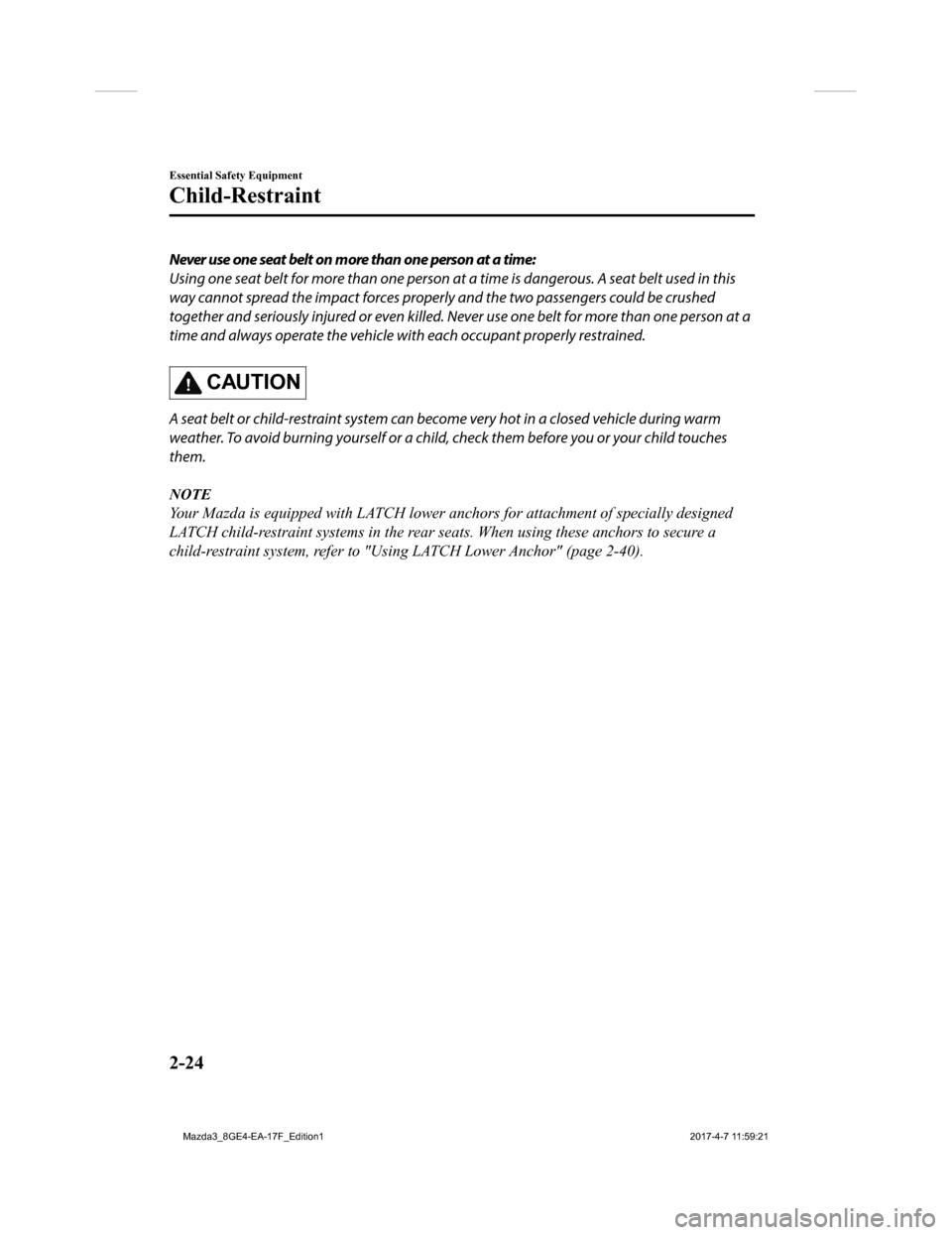
Never use one seat belt on more than one person at a time:
Using one seat belt for more than one person at a time is dangerous. A seat belt used in this
way cannot spread the impact forces properly and the two passengers could be crushed
together and seriously injured or even killed. Never use one belt for more than one person at a
time and always operate the vehicle with each occupant properly restrained.
CAUTION
A seat belt or child-restraint system can become very hot in a closed vehicle during warm
weather. To avoid burning yourself or a child, check them before you or your child touches
them.
NOTE
Your Mazda is equipped with LATCH lower an chors for attachment of specially designed
LATCH child-restraint systems in the rear seats. When using these anchors to secure a
child-restraint system, refer to "U sing LATCH Lower Anchor" (page 2-40).
Essential Safety Equipment
Child-Restraint
2-24
Mazda3_8GE4-EA-17F_Edition1 2017-4-7 11:59:21
Page 39 of 624
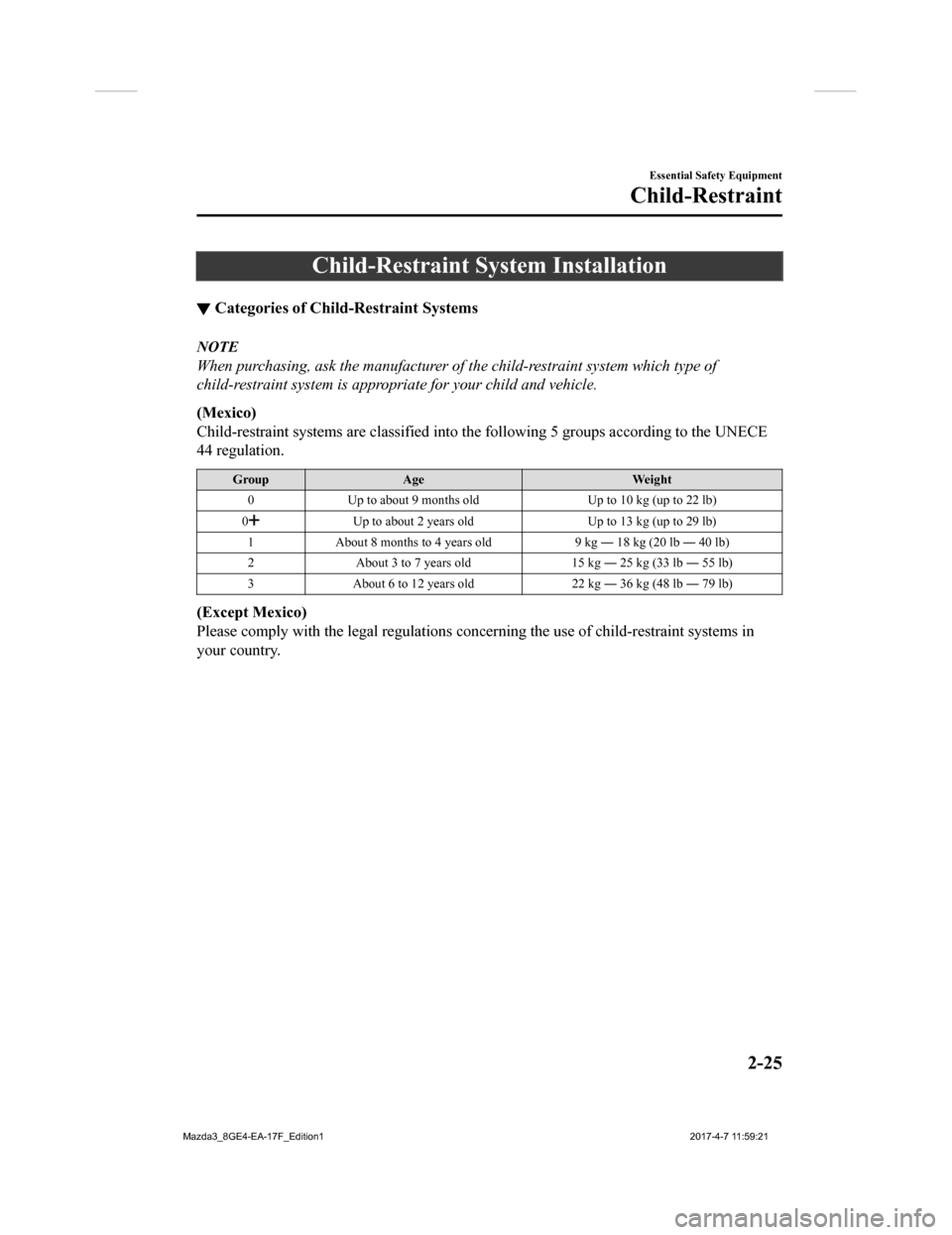
Child-Restraint System Installation
▼Categories of Child-Restraint Systems
NOTE
When purchasing, ask the manufacturer of the child-restraint system which type of
child-restraint system is appropriate for your child and vehicle.
(Mexico)
Child-restraint systems are clas
sified into the following 5 groups according to the UNECE
44 regulation.
Group Age Weight
0 Up to about 9 months old Up to 10 kg (up to 22 lb)
0
Up to about 2 years old Up to 13 kg (up to 29 lb)
1 About 8 months to 4 years old 9 kg ― 18 kg (20 lb ― 40 lb)
2 About 3 to 7 years old 15 kg ― 25 kg (33 lb ― 55 lb)
3 About 6 to 12 years old 22 kg ― 36 kg (48 lb ― 79 lb)
(Except Mexico)
Please comply with the legal regulations concerning the use of child-restraint systems in
your country.
Essential Safety Equipment
Child-Restraint
2-25
Mazda3_8GE4-EA-17F_Edition1 2017-4-7 11:59:21
Page 40 of 624
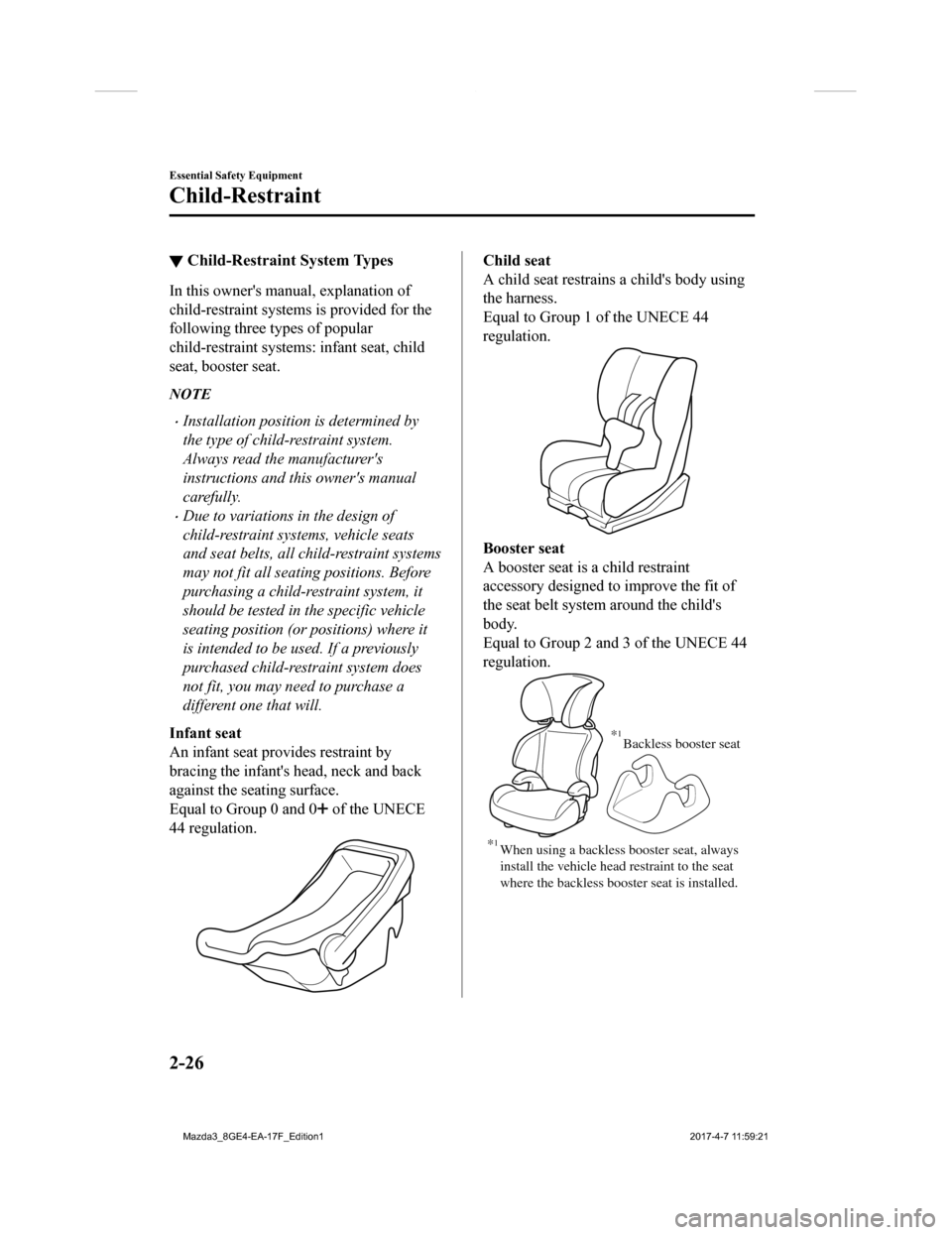
▼Child-Restraint System Types
In this owner's manual, explanation of
child-restraint system
s is provided for the
following three types of popular
child-restraint system s: infant seat, child
seat, booster seat.
NOTE
Installation position is determined by
the type of child-restraint system.
Always read the manufacturer's
instructions and this owner's manual
carefully.
Due to variations in the design of
child-restraint systems, vehicle seats
and seat belts, all child-restraint systems
may not fit all seating positions. Before
purchasing a child-restraint system, it
should be tested in the specific vehicle
seating position (or positions) where it
is intended to be used. If a previously
purchased child-restraint system does
not fit, you may need to purchase a
different one that will.
Infant seat
An infant seat provides restraint by
bracing the infant's head, neck and back
against the seating surface.
Equal to Group 0 and 0
of the UNECE
44 regulation.
Child seat
A child seat restrains a child's body using
the harness.
Equal to Group 1 of the UNECE 44
regulation.
Booster seat
A booster seat is a child restraint
accessory designed to improve the fit of
the seat belt system around the child's
body.
Equal to Group 2 and 3 of the UNECE 44
regulation.
When using a backless booster seat, always
install the vehicle head restraint to the seat
where the backless booster seat is installed.
Backless booster seat
*1
*1
Essential Safety Equipment
Child-Restraint
2-26
Mazda3_8GE4-EA-17F_Edition1
2017-4-7 11:59:21
Page 41 of 624
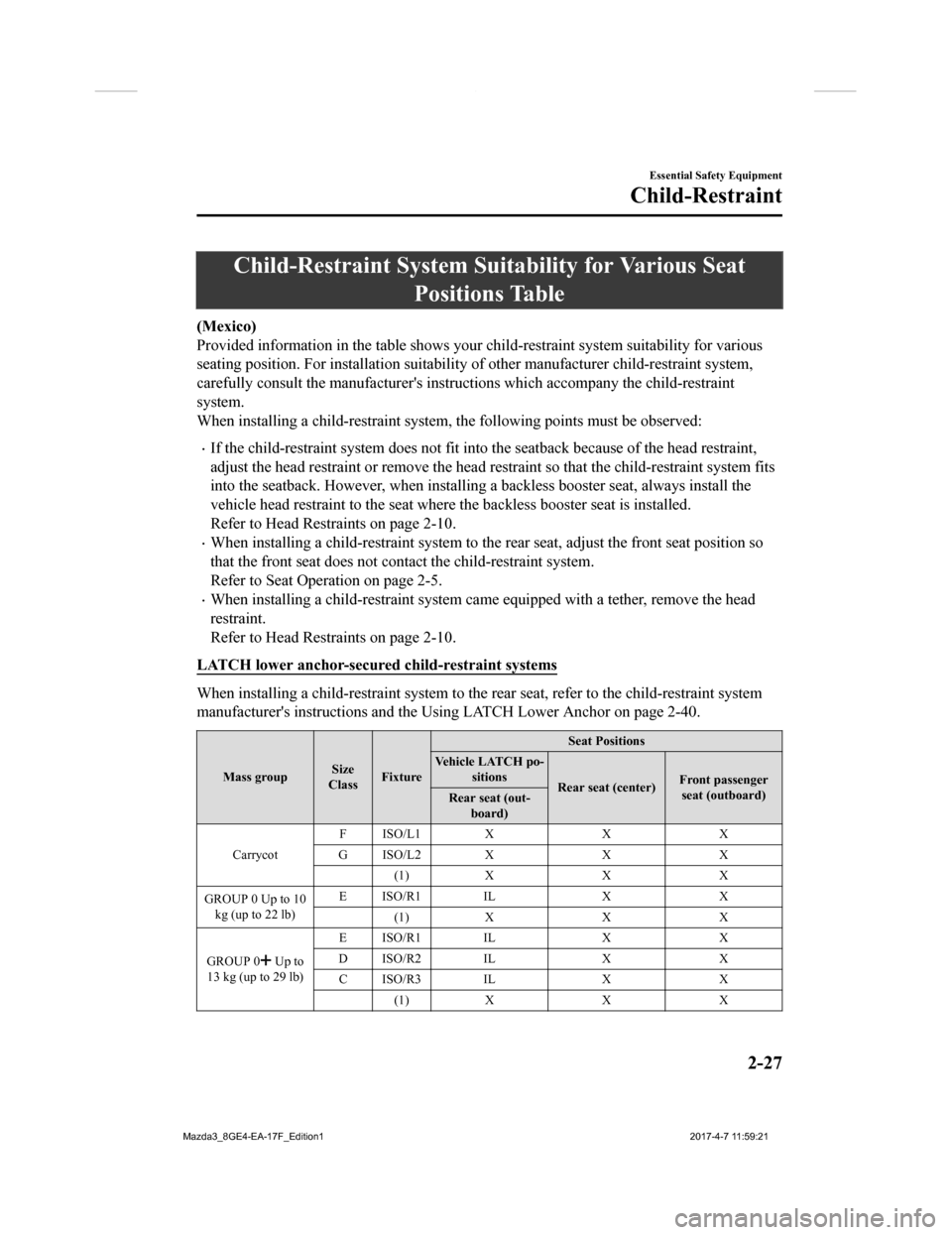
Child-Restraint System Suitability for Various Seat
Positions Table
(Mexico)
Provided information in the tabl e shows your child-restraint system suitability for various
seating position. For installation suitability of other manufac turer child-restraint system,
carefully consult the manufacture r's instructions which accompany the child-restraint
system.
When installing a child-restraint system, the following points must be observed:
If the child-restraint system does not fit into the seatback because of the head restraint,
adjust the head restraint or remove the head restraint so that the child-restraint system fits
into the seatback. However, when installing a backless booster seat, always install the
vehicle head restraint to the seat where the backless booster s eat is installed.
Refer to Head Restraints on page 2-10.
When installing a child-restrain t system to the rear seat, adjust the front seat position so
that the front seat does not contact the child-restraint system .
Refer to Seat Operation on page 2-5.
When installing a child-restraint system came equipped with a t ether, remove the head
restraint.
Refer to Head Restraints on page 2-10.
LATCH lower anchor-secured child-restraint systems
When installing a child-restraint system to the rear seat, refer to the child-restraint system
manufacturer's instructions and the Using LATCH Lower Anchor on page 2-40.
Mass groupSize
Class Fixture Seat Positions
Vehicle LATCH po- sitions Rear seat (center) Front passenger
seat (outboard)
Rear seat (out-
board)
Carrycot FISO/L1 X
XX
GISO/L2 X XX
(1) X X X
GROUP 0 Up to 10 kg (up to 22 lb) EISO/R1 IL
XX
(1) X X X
GROUP 0
Up to
13 kg (up to 29 lb) EISO/R1 IL X X
DISO/R2 IL XX
CISO/R3 IL XX
(1) X X X
Essential Safety Equipment
Child-Restraint
2-27
Mazda3_8GE4-EA-17F_Edition1 2017-4-7 11:59:21
Page 42 of 624

Mass groupSize
Class Fixture Seat Positions
Vehicle LATCH po- sitions Rear seat (center) Front passenger
seat (outboard)
Rear seat (out-
board)
GROUP 1 9 kg ― 18 kg (20 lb ― 40 lb) DISO/R2 IL
XX
CISO/R3 IL XX
BISO/F2 IUF XX
B1 ISO/F2X IUF XX
AISO/F3 IUF XX
(1) X XX
GROUP 2 15 kg ― 25 kg (33 lb ― 55 lb) (1)
X XX
GROUP 3 22 kg ― 36 kg (48 lb ― 79 lb) (1)
X XX
(1) For the CRS which do not carry the ISO/XX size class identi fication (A to G), for the applicable mass group, the
car manufacturer shall indicate t he vehicle specific LATCH child-restraint system(s) recommended for each
position.
Key of letters to be inserted in the above table:
IUF = suitable for LATCH forward child-restraints systems of universal category approved for use in this mass
group.
IL = suitable for particular LAT CH child-restraint systems (CRS ).
These LATCH CRS are those of the “specific vehicle”, “restricted” or “semi-universal” categories.
A Mazda genuine child-restraint s ystem can be installed. Regarding child-restraint systems which can be installed,
refer to the accessories catalog.
X = LATCH position not suitable fo r LATCH child-restraint systems in this mass group and/or this size class.
Essential Safety Equipment
Child-Restraint
2-28
Mazda3_8GE4-EA-17F_Edition1 2017-4-7 11:59:21
Page 43 of 624

NOTE
When installing a child-restraint system, the follo wing points must be observed:
Always remove the head restraint before in stalling a child-restraint system. However,
when installing a backless booster seat, always install the vehicle head restraint to the
seat where the backless booster seat is installed. In addition, always use a tether strap
and attach it securely. Refer to Head Restraints on page 2-10.
When installing a child-restraint system to the rear seat, adjust the front seat position so
that the front seat does not contact the child- restraint system. Refer to Seat Operation on
page 2-5.
i-Size child-restraint systems
An i-Size child-restra int system can be installed to the specif ied seat as follows:
Front passenger seat Rear seat (outboard) Rear seat (center)
i-Size child-restraint sys- tems XXX
Key of letters to be inserted in the above table:
X = Seating position not suitable for i-Size “universal” child-
restraint systems.
NOTE
An i-Size child-restraint system refers to a child-restraint system which has acquired i-Size
category certification for the UNECE 129 regulation.
Essential Safety Equipment
Child-Restraint
2-29
Mazda3_8GE4-EA-17F_Edition1 2017-4-7 11:59:21
Page 44 of 624

Seat belt-secured child-restraint systems
System group Age group Weight groupChild-restraint
system type Front pas-
sengerseat Rear seat
(outboard) Rear seat
(center)
GROUP 0 Up to about 9
months old Up to 10 kg (up
to 22 lb) Infant seat X U
L
*1
GROUP 0Up to about 2
years old Up to 13 kg (up
to 29 lb) Infant seat X U
L*1
GROUP 1About 8 months
to 4 years old 9 kg ― 18 kg (20
lb ― 40 lb) Child seat
L*2UX
GROUP 2 About 3 to 7
years old 15 kg ― 25 kg
(33 lb ― 55 lb) Booster seat
L
*2UX
GROUP 3 About 6 to 12
years old 22 kg ― 36 kg
(48 lb ― 79 lb) Booster seat
L
*2UX
Key of letters to be inserted in the above table:
U = Suitable for “univ ersal” category restraints approved for u se in this mass group.
L = A Mazda genuine child-restrai nt system can be installed. Regarding child-restraint systems which can be
installed, refer to the accessories catalog.
X = Seat position not suitable for children in this mass group.
*1 When a child-restraint system is installed to the rear center seat, do not seat occupants in the rear right
outboard seat position.
*2 When installing a child-restraint system to the front passenge r seat, adjust the seat slide position as far back as
possible. Adjust the se at bottom to the highest position so tha t the seat belt can securely fasten the
child-restraint system.
Refer to Seat Operation on page 2-5.
NOTE
When installing a child-restraint system, the following points must be observed:
Always remove the head restraint before installing a child-restraint system. However,
when installing a backless booster seat, always install the vehicle head restraint to the
seat where the backless booster seat is instal led. In addition, always use a tether strap
and attach it securely. Refer to Head Restraints on page 2-10.
When installing a child-restraint system to the rear seat, adjust the front seat position so
that the front seat does not contact the child-restraint system. Refer to Seat Operation 2-5.
(Except Mexico)
Please comply with the legal regulations concerning the use of child-restraint systems in
your country.
Essential Safety Equipment
Child-Restraint
2-30
Mazda3_8GE4-EA-17F_Edition1 2017-4-7 11:59:21
Page 45 of 624

Installing Child-RestraintSystems
Accident statistics reveal that a child is
safer in the rear seat . The front passenger's
seat is clearly the worst choice for any
child under 12, and with rear-facing
child-restraint systems it is clearly unsafe
due to air bags.
NOTE
Even if your vehicle is equipped with front
passenger occupant classification sensor
(page 2-61), which automatically
deactivates the front passenger air bag, a
rear seat is the safest place for a child of
any age or size.
Some child-restraint systems now come
with tethers and therefore must be
installed on the seats that take tethers to be
effective. In your Mazda, tethered
child-restraint systems can only be
accommodated in the three positions on
the rear seat.
Some child-restraint systems also employ
specially designed LATCH attachments;
refer to "Using LATCH Lower Anchor"
(page 2-40).
WA R N I N G
Tethered Child-Restraint Systems Work
Only on Tether-Equipped Rear Seats:
Installation of a tether equipped
child-restraint system in the front
passenger's seat defeats the safety design
of the system and will result in an increased
chance of serious injury if the
child-restraint system goes forward
without benefit of being tethered.
Place tether equipped child-restraint
systems where there are tether anchors.
Essential Safety Equipment
Child-Restraint
2-31
Mazda3_8GE4-EA-17F_Edition1 2017-4-7 11:59:21
Page 46 of 624
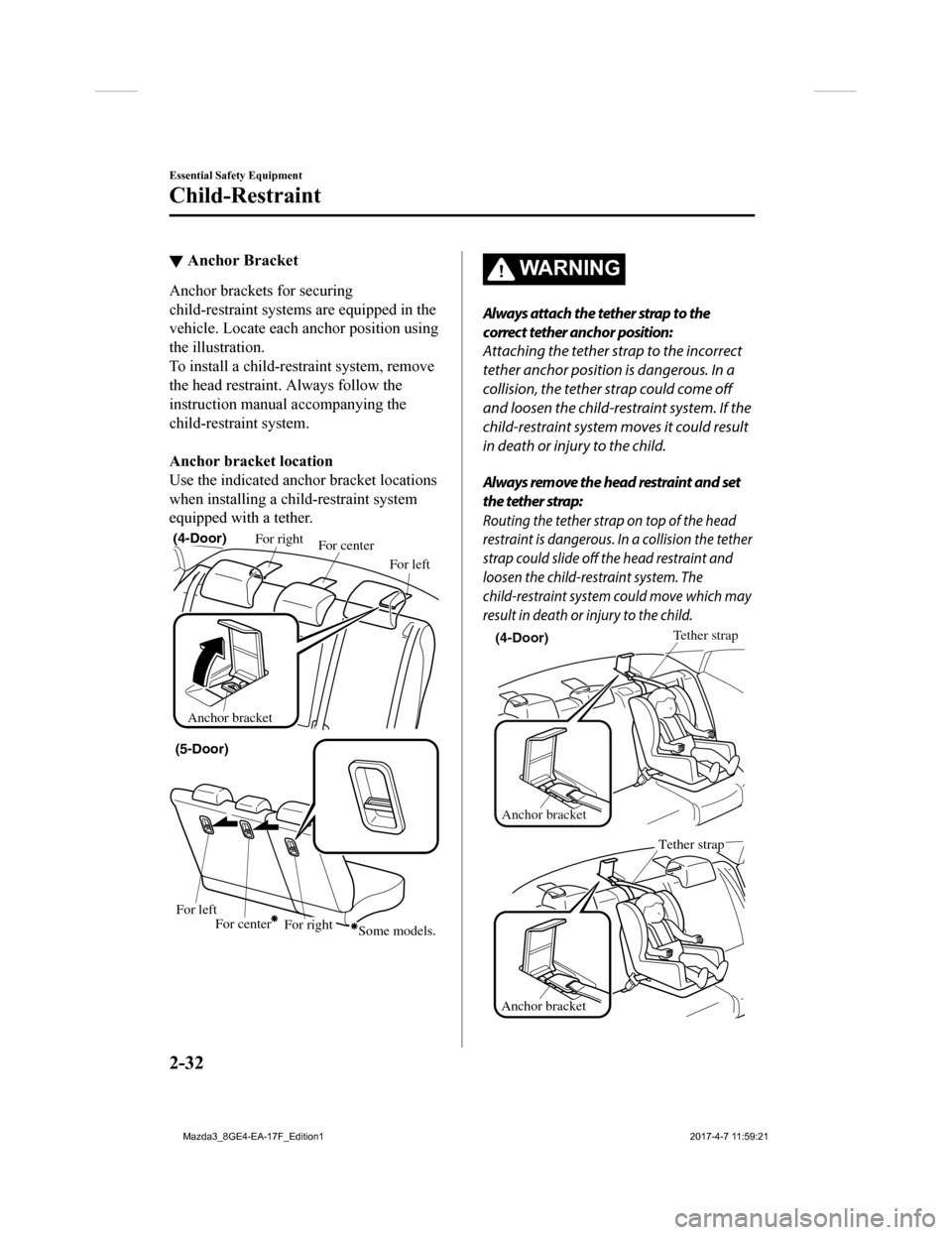
▼Anchor Bracket
Anchor brackets for securing
child-restraint systems are equipped in the
vehicle. Locate each anchor position using
the illustration.
To install a child-restraint system, remove
the head restraint. Always follow the
instruction manual accompanying the
child-restraint system.
Anchor bracket location
Use the indicated anchor bracket locations
when installing a child-restraint system
equipped with a tether.
Anchor bracket For right
For left
For center
(4-Door)
(5-Door)
For left
For centerFor rightSome models.
WA R N I N G
Always attach the tether strap to the
correct tether anchor position:
Attaching the tether strap to the incorrect
tether anchor position is dangerous. In a
collision, the tether strap could come off
and loosen the child-restraint system. If the
child-restraint system moves it could result
in death or injury to the child.
Always remove the head restraint and set
the tether strap:
Routing the tether strap on top of the head
restraint is dangerous. In a collision the tether
strap could slide off the head restraint and
loosen the child-restraint system. The
child-restraint system could move which may
result in death or injury to the child.
Anchor bracket
Tether strap(4-Door)
Anchor bracket
Tether strap
Essential Safety Equipment
Child-Restraint
2-32
Mazda3_8GE4-EA-17F_Edition1 2017-4-7 11:59:21